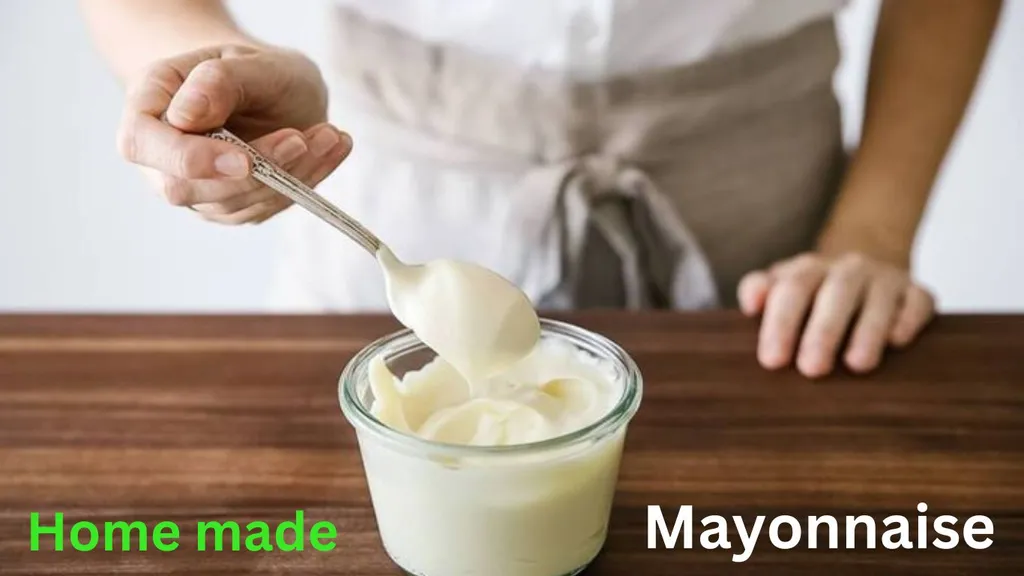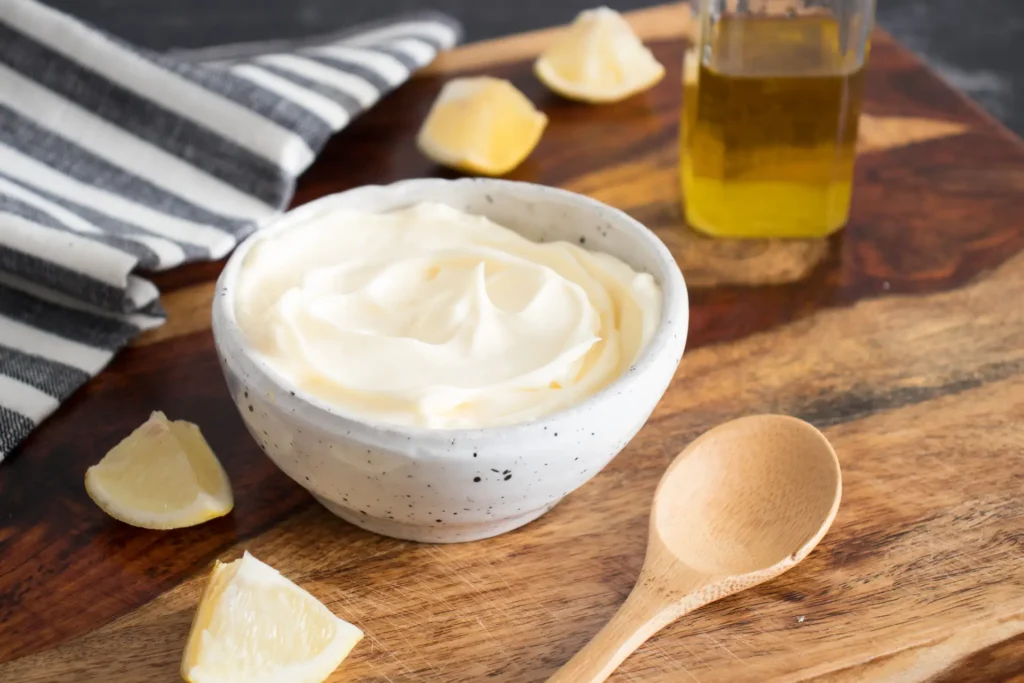Homemade mayonnaise is a game-changer in the kitchen. It’s fresher, creamier, and free from artificial preservatives that store-bought versions contain. Once you try a homemade mayonnaise recipe, you’ll never go back to the jarred stuff. Not only is it easy to make, but you also get to control the ingredients, ensuring the best flavor and quality.
In this guide, you’ll learn how to make homemade mayonnaise, the best ingredients to use, how to store it safely, and delicious ways to enjoy it. Whether you’re looking for a healthy homemade mayonnaise version or a homemade mayonnaise without mustard, this article covers it all.
How to Make Mayonnaise
Learning how to make a homemade mayonnaise is simpler than most people think. The key is emulsification—blending oil, egg, and acid together until you get a thick and creamy consistency.
Classic Recipe for Homemade Mayonnaise
| Ingredient | Quantity |
|---|---|
| Egg (room temperature) | 1 large |
| Dijon mustard | 1 tbsp |
| White wine vinegar or lemon juice | 1 tbsp |
| Salt | ¼ tsp |
| Oil (neutral-flavored) | 1 cup |
| Lemon juice (optional, for extra tang) | 1 tsp |
To start, place the egg, mustard, vinegar, and salt in a food processor or use a homemade mayonnaise immersion blender. Blend for about 20 seconds until combined. Then, slowly add the oil in tiny drops while blending continuously. This slow addition is crucial for emulsification. If you pour the oil too quickly, the mixture will separate instead of thickening.
Once the mayonnaise reaches the desired consistency, taste it and adjust with more salt or lemon juice if needed. This easy homemade mayonnaise takes less than 10 minutes and tastes far better than anything you’ll find at the store.
How Long Does Homemade Mayonnaise Last?
A common question is, “how long is homemade mayonnaise good for?” Unlike commercial mayonnaise, which contains preservatives, homemade mayonnaise how long does it last depends on storage conditions.
When stored in an airtight container in the refrigerator, it lasts about 7 to 14 days. However, freshness depends on the quality of the ingredients, especially the eggs.
| Storage Condition | Shelf Life |
|---|---|
| Refrigerated (airtight container) | 7-14 days |
| Left at room temperature | Not safe! Use immediately |
| Made with pasteurized eggs | Up to 2 weeks |
Always check for signs of spoilage, such as a sour smell, discoloration, or separation. If your mayonnaise looks or smells off, it’s best to throw it out.
Delicious Ways to Use Homemade Mayonnaise
There are countless ways to enjoy mayonnaise homemade beyond spreading it on sandwiches. Its creamy texture and rich flavor make it a versatile ingredient in many dishes.
Popular Uses for Homemade Mayonnaise
-
Classic Salads – Homemade mayonnaise recipes enhance dishes like potato salad, egg salad, coleslaw, and tuna salad.
-
Dips & Sauces – Use homemade mayonnaise with avocado oil as a base for ranch dressing, garlic aioli, or spicy Sriracha mayo.
-
Cooking Ingredient – Coat chicken or fish before baking to lock in moisture.
-
Grilled Cheese & Burgers – Spread a thin layer on the outside of your bread instead of butter for a crispy, golden crust.
If you’ve never tried homemade mayonnaise olive oil, it’s a fantastic option for making lighter dressings and spreads while maintaining a silky texture.
Fail-Proof Homemade Mayonnaise
One of the biggest challenges when learning how do you make homemade mayonnaise is getting the emulsification right. Sometimes, it breaks, leaving you with a runny mess. But don’t worry—there’s a simple fix!
How to Fix Broken Mayonnaise
If your mayonnaise recipe homemade separates, try this trick:
-
In a clean bowl, add 1 fresh egg yolk and ½ teaspoon vinegar.
-
Slowly whisk in the broken mayonnaise, one spoonful at a time.
-
Continue until the mixture thickens again.
Adding mustard helps keep the mixture stable, but if you prefer homemade mayonnaise without mustard, use extra lemon juice or vinegar to help with emulsification.
Homemade Mayonnaise Without Mustard
Many recipes include mustard because it helps emulsify the ingredients. However, you can still make a homemade mayonnaise without mustard by replacing it with an acidic ingredient like lemon juice or vinegar.
For this version, follow the same recipe for homemade mayonnaise, but increase the vinegar or lemon juice by an extra teaspoon. The texture may be slightly less stable, so be extra careful when adding the oil slowly.
Healthy Homemade Mayonnaise
Making healthy homemade mayonnaise at home allows you to use better-quality oils and avoid preservatives. Store-bought mayo often contains soybean oil, artificial stabilizers, and added sugar, which aren’t the healthiest options.
Healthier Oil Options for Mayonnaise
| Type of Oil | Health Benefits |
|---|---|
| Avocado Oil | High in heart-healthy monounsaturated fats |
| Olive Oil | Rich in antioxidants, great for a Mediterranean diet |
| Coconut Oil | Adds a slightly sweet flavor, antibacterial properties |
If you’re looking for a homemade healthy mayonnaise recipe, swap vegetable oil for avocado or olive oil, and use Greek yogurt instead of some of the oil to reduce the fat content while maintaining creaminess.
Key Ingredients for Homemade Mayonnaise
The best homemade mayonnaise recipes start with fresh, high-quality ingredients. Here’s why each ingredient matters:
-
Eggs – Use fresh, pasteurized eggs for safety and richness.
-
Oil – Choose a neutral-flavored oil like safflower or canola, or go for a homemade mayonnaise olive oil version for a richer taste.
-
Acid (Vinegar or Lemon Juice) – Helps with emulsification and adds brightness to the flavor.
-
Salt & Seasonings – Essential for balance; garlic, paprika, or herbs can enhance the taste.
Is Homemade Mayonnaise Safe?
A major concern with how to make homemade mayonnaise is the use of raw eggs. While most people consume raw eggs without issue, there is a small risk of salmonella.
To minimize risk, use pasteurized eggs, which have been heated just enough to kill bacteria without cooking the egg. You can also pasteurize eggs at home by heating them to 140°F (60°C) for 3 minutes.
Always store homemade mayonnaise in the fridge and avoid leaving it at room temperature for extended periods.
FAQs About Homemade Mayonnaise
Q:What is the best oil for homemade mayonnaise?
A:Vegetable oil or canola oil.
Q:Is mustard unhealthy?
A:Eating mustard seeds, leaves, or paste is generally considered safe for most people.
Q:What is better than mayonnaise?
A:A full fat, plain Greek yogurt, mashed avocado, or just a mix of olive oil and an acidic liquid like red wine vinegar or lemon juice,
Q:Is mayo bad for cholesterol?
A:A tablespoon of most regular mayos has a trivial 5 to 15 milligrams of cholesterol.
Final Thoughts
Making homemade mayonnaise is easier than most people think, and the result is far superior to anything store-bought. Whether you prefer a healthy homemade mayonnaise recipe, a mayonnaise homemade with olive oil, or a homemade mayonnaise without mustard, there’s a version for everyone.
Try this recipe for homemade mayonnaise today and see the difference for yourself! Once you master how to make homemade mayonnaise, you’ll never go back to store-bought again.













